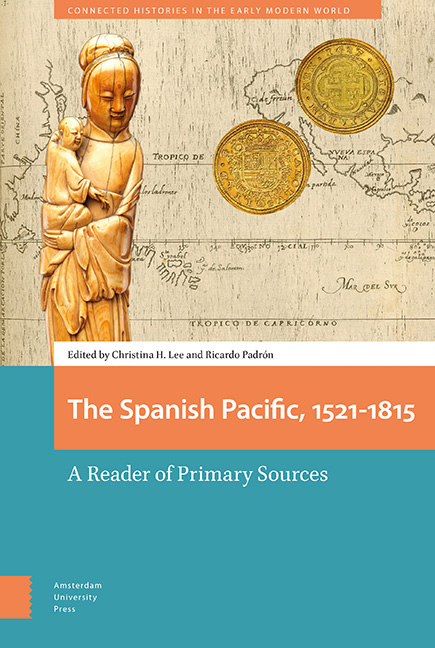Book contents
- Frontmatter
- Contents
- Abbreviations
- Acknowledgements
- Introduction
- 1 An Early Transpacific Account of the Spice Islands by Andrés de Urdaneta (1536)
- 2 Domingo de Salazar’s Letter to the King of Spain in Defense of the Indians and the Chinese of the Philippine Islands (1582)
- 3 Juan Cobo’s Map of the Pacific World (1593)
- 4 A Royal Decree of Philip III Regulating Trade between the Philippines and New Spain (1604)
- 5 Manila’s Sangleys and a Chinese Wedding (1625)
- 6 Don Luis Castilla Offers to Sell Land in Manila (1629)
- 7 Idolatry and Apostasy in the 1633 Jesuit Annual Letter
- 8 The Will of an Indian Oriental and her Chinos in Peru (1644
- 9 Francisco de Combés’s History of Mindanao and Jolo (1667)
- 10 Between Fiction and History in the Spanish Pacific The Misfortunes of Alonso Ramírez (1690)
- 11 A Moluccan Crypto-Muslim before the Transpacific Inquisition (1623–1645)
- 12 Constitutions and Rules of the Beatas Indias (1726)
- 13 The Poetics of Praise and the Demands of Confession in the Early Spanish Philippines: Notes and Documents
- 14 The Pacific Theater of the Seven Years’ War in a Latin Poem by an Indigenous Priest, Bartolomé Saguinsín (1766)
- 15 A Prohibition on Digging Up the Bones of the Dead (1813)
- Index
14 - The Pacific Theater of the Seven Years’ War in a Latin Poem by an Indigenous Priest, Bartolomé Saguinsín (1766)
Published online by Cambridge University Press: 20 November 2020
- Frontmatter
- Contents
- Abbreviations
- Acknowledgements
- Introduction
- 1 An Early Transpacific Account of the Spice Islands by Andrés de Urdaneta (1536)
- 2 Domingo de Salazar’s Letter to the King of Spain in Defense of the Indians and the Chinese of the Philippine Islands (1582)
- 3 Juan Cobo’s Map of the Pacific World (1593)
- 4 A Royal Decree of Philip III Regulating Trade between the Philippines and New Spain (1604)
- 5 Manila’s Sangleys and a Chinese Wedding (1625)
- 6 Don Luis Castilla Offers to Sell Land in Manila (1629)
- 7 Idolatry and Apostasy in the 1633 Jesuit Annual Letter
- 8 The Will of an Indian Oriental and her Chinos in Peru (1644
- 9 Francisco de Combés’s History of Mindanao and Jolo (1667)
- 10 Between Fiction and History in the Spanish Pacific The Misfortunes of Alonso Ramírez (1690)
- 11 A Moluccan Crypto-Muslim before the Transpacific Inquisition (1623–1645)
- 12 Constitutions and Rules of the Beatas Indias (1726)
- 13 The Poetics of Praise and the Demands of Confession in the Early Spanish Philippines: Notes and Documents
- 14 The Pacific Theater of the Seven Years’ War in a Latin Poem by an Indigenous Priest, Bartolomé Saguinsín (1766)
- 15 A Prohibition on Digging Up the Bones of the Dead (1813)
- Index
Summary
Abstract
The Latin epigrams of the Tagalog parish priest Bartolomé Saguinsín (c.1696–1772) commemorate the loss of Manila to the British East India Company in the Seven Years’ War, and the subsequent recuperation of the city by Spain. They plot events into a predictably providentialist structure, lionizing the Spanish commander, praising the Hispanized natives who helped recover the city, criticizing the inhabitants of less Hispanized areas who stood idly by, and casting aspersions on the Sangleys who supposedly collaborated with the invaders. Stuart M. McManus provides background on the author and his involvement with the war, and discusses the poem as an instance of participation by a Tagalog native in the Catholic Republic of Letters.
Keywords: Neo-Latin poetry; imperial rivalry in the Pacific; Seven Years’ War; Filipino literature
The following text is a translation of a collection of Latin epigrams by the erudite Tagalog priest, Bartolomé Saguinsín (c.1696–1772). This recounts one of the most important events in both the history of the Hispanic world and the Philippine nation, the British occupation of Manila during the Seven Years’ War (1762–1764). It is also worth noting that it is dedicated to the lieutenant governor of the Philippines, Simón de Anda y Salazar (1709–1776), and that it was printed thanks to the generosity of Mateo de los Angeles (dates unknown), a Chinese mestizo militiaman, who before the War had spent some time at the court of Philip V in Madrid.
As for the author himself, Saguinsín was born in 1694 in Antipolo on the outskirts of Manila to a family of Hispanized Tagalog principales, and attended the Jesuit school in the town, before receiving a degree in arts from the Real Colegio de San José in Manila. From there, he quickly rose in the church hierarchy, eventually becoming the parish priest of Quiapo, a canon of the cathedral and synodal examiner of morality and the Tagalog language. It was in this final capacity that in the 1750s he was asked to re-edit the Tagalog Doctrina Christiana, a central text for indigenous Christianity.
- Type
- Chapter
- Information
- Spanish Pacific, 1521–1815A Reader of Primary Sources, pp. 223 - 238Publisher: Amsterdam University PressPrint publication year: 2020
- 1
- Cited by



